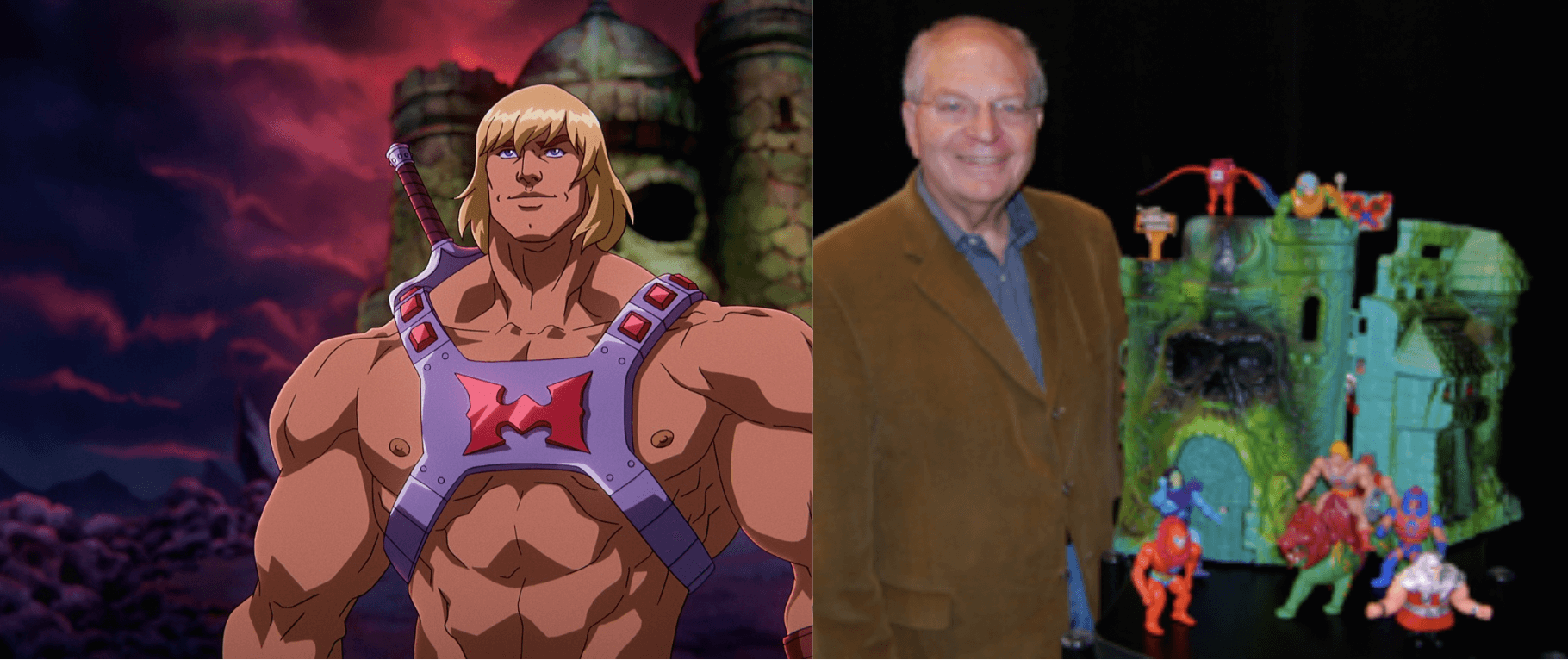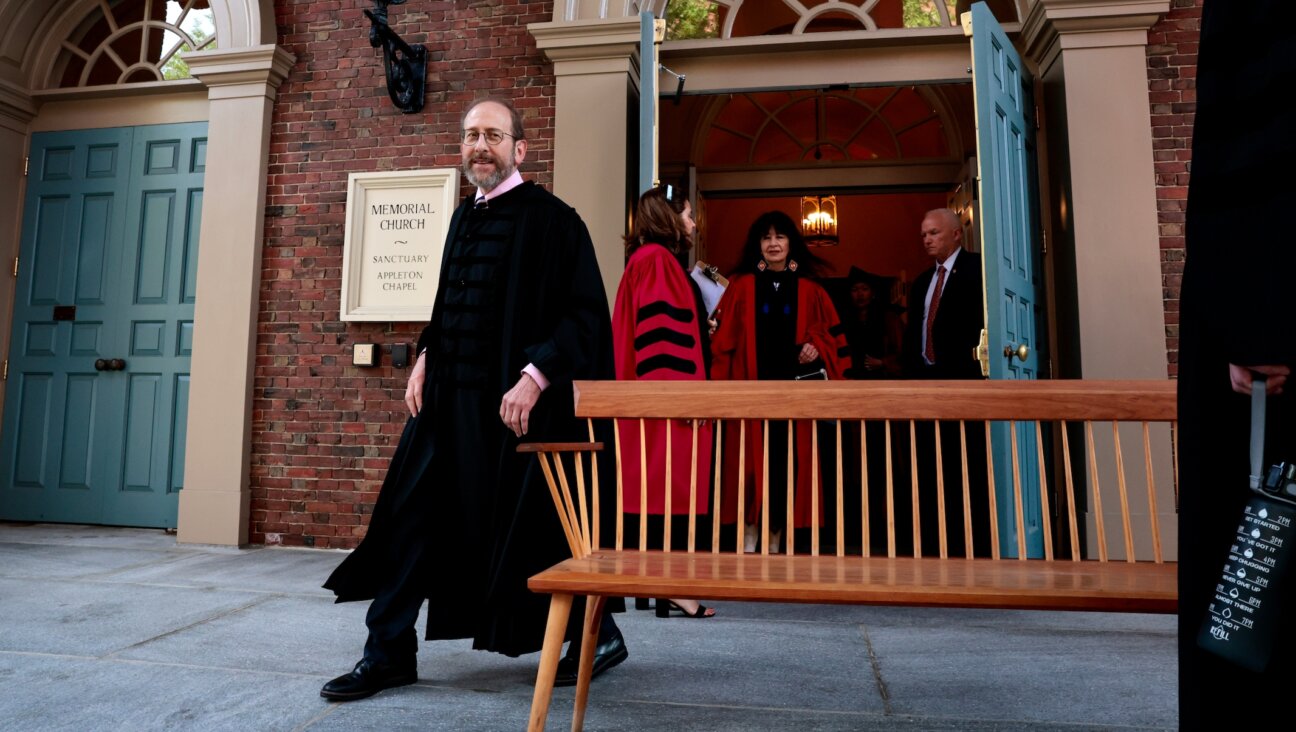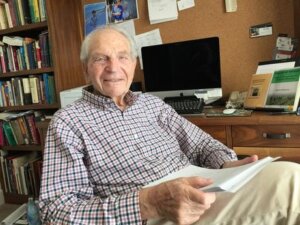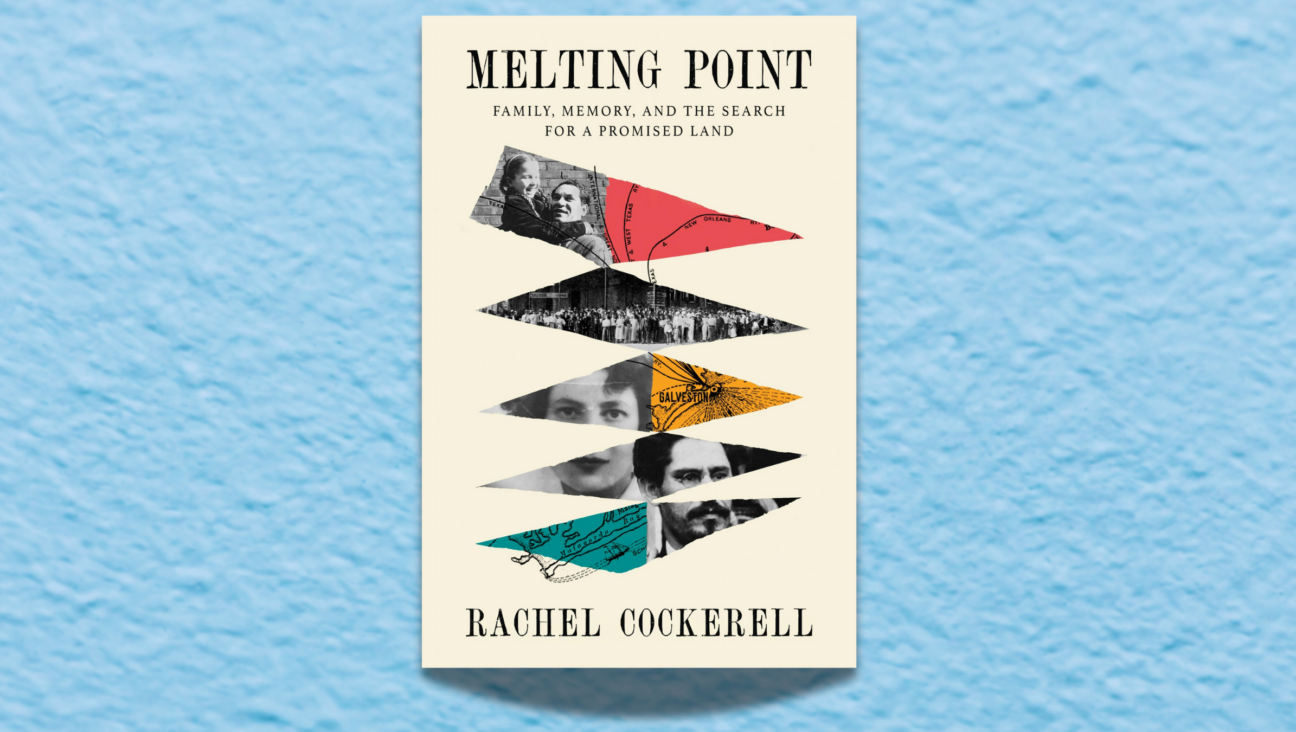How the Hebrew Bible helped me write He-Man (and a Salvation Army special)
The man who developed ‘Masters of the Universe’ explains Eternia’s undersung Yiddishkeit

He-Man stands before Castle Grayskull. The author poses with Masters of the Universe toys. Photo by Netflix/Michael Halperin
As a New Jersey kid in the 1940s, every Saturday morning when I should have been in shul, I listened to the radio show Let’s Pretend floating across the Hudson River from a New York studio broadcasting myths and folktales. At the end of each program they announced, “If you live in or near New York and would like to see a broadcast of Let’s Pretend, drop a postcard to CBS, New York, for your ticket.”
Tickets arrived and off I went expecting to see princes and princesses, evil stepmothers. Instead, ordinary men, women, and child actors stood in front of microphones reading scripts, while a sound effects artist clapped halves of a coconut together mimicking horse hooves on cobblestones. It was magic and I wanted to wear the magician’s top hat.
Studies in cheder after school introduced me to storytelling of a different métier. Fantasies in the holy texts we read had mystical angels, miracles — wonders of Let’s Pretend — but they were my stories. During sweltering summers our scout troop had sleepovers in the Jersey Pines. Around a fire, the boys asked me to tell a story. Picking out passages from Torah about dysfunctional families, brother against brother, I turned them into ghost stories, scaring the hell out of kids bundled in sleeping bags too frightened to close their eyes in a dark spooky forest.
The year of my bar mitzvah, we moved to California — Hollywood, Beverly Hills, motion pictures. As editor of the high school newspaper, I wrote whatever I wanted, some of which elaborated upon reality. Students ate it up, and it was the first time I discovered the power of words.
The winter of my junior year, Mr. Cutlip gave those of us in his English class an assignment to write a short story. I startled my instructor by writing a weird secular tale about the birth of Jesus. Asked why I chose to write about Jesus, this 16-year-old Jersey wise guy said, “Jesus was a Jew. Who knows better how to tell his story?”
A few weeks later, a check from a major magazine arrived. It planned to publish the story in their Christmas issue. Unknown to me, my teacher had submitted the story on my behalf. “Easy money,” I thought. That may have been the moment when writing became my insane plan for the future.
After graduating with a degree in communications from the University of Southern California, Warner Bros. hired me as a film editor, not a writer. I pushed and pulled, sending scripts to producers of series I edited. Nothing sold. Fortune fell upon me when one of the major aerospace companies in Los Angeles hired me to write, produce and direct documentary films. It was good work, but didn’t satisfy my yearning to write drama.
Out of the blue, a friend suggested writing a dramatic radio show. Radio drama? Dead and gone — except for one lone program sponsored by the Salvation Army, Heartbeat Theater, with the slogan “Hand to man, heart to God.” After researching Salvation Army history, I found a 19th century incident involving Catherine “La Maréchale” Booth, daughter of the Salvation Army’s founder. Imprisoned in Switzerland for preaching her version of Christianity in the austere Calvinist nation — I chose her story as my subject. But I faced a conundrum. The grief-stricken young woman, alone in a jail cell, had to express her anguish. It’s radio. Not TV. Not a motion picture.
Yom Kippur approached and what better way to bemoan her fate than the familiar, to me, words of the Al Chet (repurposed for the episode): “For the sin I have committed by hard-heartedness, etc.” Producers and Salvation Army consultants had no idea where the brilliant soliloquy came from. Once again, Jewishness served me in writing a Christian story. Who’s better acquainted with suffering and atonement?
A few years later, a director I worked with asked me to write the script for an animated TV musical, produced this time by the Lutheran Church. I had blonde hair and blue eyes and had been mistaken for Scandinavian. The director knew I was Jewish, but the Lutherans didn’t. The musical, Easter Is… with a Jimmy Haskell score, and Lesley Uggams voicing and singing the Mother, played on Easter for about four years. In it, a bully kidnaps a boy’s dog, and the boy fears his pet’s been killed. In the end, the dog escapes, rejoining his family just as they’re going to church. The director, originally from Brooklyn, congratulated me, “Only a Jew could get away with resurrecting a dog on Easter.”
Flash forward to 1980. Quincy, starring Jack Klugman, the first live action TV series I wrote, fit in with my pro-social views. While waiting for another assignment, a call came asking me to write a script titled “Tower of Babel” for NBC’s Greatest Heroes of the Bible. Researching Jewish commentaries, I wrote a script with a philosophical twist. Unfortunately, the producers had their own ideas. Although Nimrod was the king of Babel in Midrash, they wanted to use him as a hero in another episode. Therefore, Nimrod out, fictitious king in. To make matters worse, they insisted that the first scene show his cruelty. I asked for suggestions. They replied, “He kicks a crutch out from under a cripple.” My reply: “Get someone else to rewrite the episode.”
The Quincy episode resulted in a contract with Universal and then 20th Century Fox, as story editor, executive story consultant and producer. On the side I wrote screenplays. A friend working in public relations at Mattel read a sword and sorcery script I had written. He asked if I would be interested in meeting the Director of Male Action Figures. A week later, I rode the infamous I-405 to Mattel in Inglewood and was ushered into his office. After regaling me with congratulations on my imaginative writing, he revealed his reason for the meeting.
Mattel had a male action toy set called “He-Man and the Masters of the Universe,” and it had one major problem. Kids found it difficult differentiating between good guys and bad guys. Mini-comics enclosed in boxes with the figures had varying origin stories that confused youngsters. The company planned to produce an animated series based on the action figures and needed coherence. They asked me to develop an extensive “bible” for marketing and the series (you can guess what I used for inspiration) and create 10 mini-comics maintaining a strong, consistent storyline.
With the able assistance of toy designers and a brilliant marketing executive, I undertook the task of bringing Masters of the Universe to life. The throughline of the series demonstrated that wits overcame wrath (see the stories of Joseph and his brothers, reunion of Ishmael and Isaac, and Jacob and Esau). The subtext of the series came from the Maccabees, a small band of the righteous led by a fearless warrior (He-Man/Judah Maccabee), defeating the enemy (Skeletor/Antiochus) hell-bent on conquering all Eternia.
The series debuted in 1983, and became one of the most successful animated series at the time. I served as Mattel and Filmation’s script consultant for the first year, returning to live-action TV to write and produce a pilot for an adventure series. The Maccabee subtext slowly faded away.
In 2002, Mattel called on me to revive the series for its 20th anniversary. Working with a different staff and new animation house, my original vision took off. In one episode He-Man raises the Sword of Power and instead of calling out his catch phrase, “I have the power,” I wrote: “Who is for peace and justice, follow me,” a paraphrase of Mattathias’ call, “Let everyone who is zealous for the Law, follow me.”
The series has held up with unexpected outcomes. As adjunct faculty in Loyola Marymount University’s School of Cinema and Television, it came as a revelation that students not old enough to have seen the original Masters when it aired, took my class because of my association with the series.
An interesting point of view about Masters came in the mail a few years ago from a university student who wrote his Master’s (no pun intended) thesis based on the series. He recognized the Books of Samuel in it, but also wrote, “The narrative refers to He-Man as ‘the paladin,’ ‘bearer of all Eternia’s virtue,’ and ‘the planet’s savior.’ These messianic overtones crescendo in Halperin’s story when The Sorceress tells He-Man that, ‘Perhaps in time, he would rule, as the true master of the universe.’” Messianic concepts were farthest from my mind.
Seeing Masters through its first year, Mattel, the animation company, and I hoped for success. It took off like a rocket becoming a major hit with a long life and numerous iterations. It continues to astonish me how it inspires, makes one think, and, to some, makes a philosophical statement. I can only ascribe its success and large fan base to a story resonating with familiar myths and tales. The subtle use of the Maccabean revolt, along with tales in Genesis, formed the underpinning of the series, a narrative of heroes facing enormous odds, emerging victorious.
And to think it all started with me listening to a radio program when I should have been in shul.
The Forward is free to read, but it isn’t free to produce

I hope you appreciated this article. Before you go, I’d like to ask you to please support the Forward.
Now more than ever, American Jews need independent news they can trust, with reporting driven by truth, not ideology. We serve you, not any ideological agenda.
At a time when other newsrooms are closing or cutting back, the Forward has removed its paywall and invested additional resources to report on the ground from Israel and around the U.S. on the impact of the war, rising antisemitism and polarized discourse.
This is a great time to support independent Jewish journalism you rely on. Make a Passover gift today!
— Rachel Fishman Feddersen, Publisher and CEO
Most Popular
- 1

News Student protesters being deported are not ‘martyrs and heroes,’ says former antisemitism envoy
- 2

News Who is Alan Garber, the Jewish Harvard president who stood up to Trump over antisemitism?
- 3

Politics Meet America’s potential first Jewish second family: Josh Shapiro, Lori, and their 4 kids
- 4

Fast Forward Suspected arsonist intended to beat Gov. Josh Shapiro with a sledgehammer, investigators say
In Case You Missed It
-
Fast Forward Jewish students, alumni decry ‘weaponization of antisemitism’ across country
-

Opinion I first met Netanyahu in 1988. Here’s how he became the most destructive leader in Israel’s history
-

Opinion Why can Harvard stand up to Trump? Because it didn’t give in to pro-Palestinian student protests
-

Culture How an Israeli dance company shaped a Catholic school boy’s life
-
Shop the Forward Store
100% of profits support our journalism
Republish This Story
Please read before republishing
We’re happy to make this story available to republish for free, unless it originated with JTA, Haaretz or another publication (as indicated on the article) and as long as you follow our guidelines.
You must comply with the following:
- Credit the Forward
- Retain our pixel
- Preserve our canonical link in Google search
- Add a noindex tag in Google search
See our full guidelines for more information, and this guide for detail about canonical URLs.
To republish, copy the HTML by clicking on the yellow button to the right; it includes our tracking pixel, all paragraph styles and hyperlinks, the author byline and credit to the Forward. It does not include images; to avoid copyright violations, you must add them manually, following our guidelines. Please email us at [email protected], subject line “republish,” with any questions or to let us know what stories you’re picking up.













